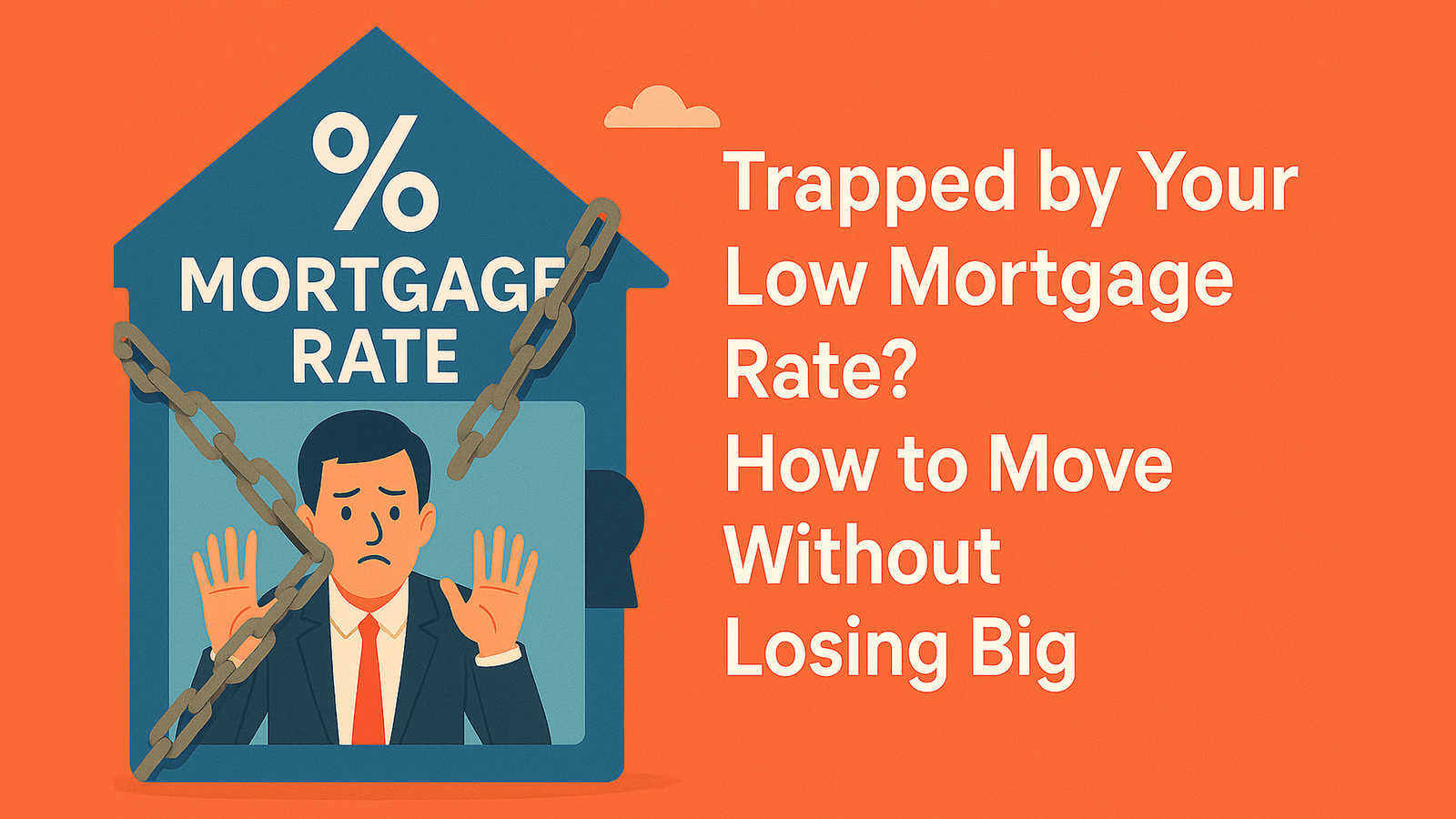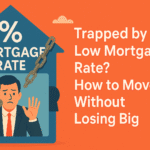You scored a low mortgage rate—maybe back when rates were in the 2s or 3s—and now, you’re feeling stuck. Sound familiar? You want to upgrade, downsize, relocate, or maybe just change scenery, but the thought of trading that golden mortgage for today’s sky-high rates makes your wallet sweat.
So, what do you do? Are you really trapped forever?
Not quite. Let’s walk through this together and explore some creative, financially savvy strategies that let you make your move without throwing away your low mortgage rate advantage. We’ll cover everything from renting out your home to mortgage recasting—so buckle up, because this might be the housing advice you didn’t know you needed.
Why Are Low Mortgage Rates So Hard to Walk Away From?
Before we dive into solutions, let’s understand the why behind this emotional and financial dilemma.
What Makes a Low Mortgage Rate So Valuable?
When mortgage rates were in the 2–3% range, it was like a once-in-a-generation sale on borrowing money. A low interest rate means:
- Lower monthly payments
- Less interest paid over time
- More flexibility in your budget
Now, with rates hovering in the 6–7% zone (and beyond), that low rate is like holding a winning lottery ticket—one you don’t want to cash out.
The Cost of Moving Now vs. Then
Let’s do a quick comparison.
If you bought your house with a $300,000 loan at 3%, your monthly principal and interest is about $1,265.
That same loan at 7%? You’re suddenly paying $1,996. That’s a $731 monthly difference—over $8,700 per year!
No wonder you’re reluctant to move. But don’t worry—there are options that won’t leave you feeling financially blindsided.
Can You Move Without Giving Up Your Low Rate?
Absolutely. Here’s how smart homeowners are doing it.
1. Rent Out Your Home and Buy Another
One clever strategy is to rent out your current home and use the rental income to help finance a new one.
Why This Works
- You keep your low mortgage rate
- Rental income can offset your new mortgage
- You potentially build wealth through real estate
What to Watch Out For
- You’ll need enough savings or income to qualify for a second mortgage
- Local rental laws and landlord responsibilities can get tricky
- Consider property management if you’re moving far away
Learn more click here.
2. Try a Mortgage Recast
If you’ve got some extra cash on hand, a mortgage recast could work in your favor.
What is a Mortgage Recast?
It’s when you make a large lump-sum payment on your mortgage, and your lender recalculates your monthly payment based on the new (lower) balance—without changing your interest rate.
When to Consider It
- You’re not moving far and want to reduce monthly obligations
- You want to free up cash flow for a second property
- You’re using proceeds from selling another asset
Note: Not all loans qualify for a recast, so check with your lender.
3. Use Your Equity to Your Advantage
If you’ve owned your home for a few years, you probably have a decent amount of equity.
Options for Using Equity:
- Home Equity Line of Credit (HELOC): Borrow against your equity to fund a down payment.
- Cash-Out Refinance: Not ideal if it means losing your low rate, but may work if the new use of funds outweighs the cost.
- Bridge Loan: Helps you buy before selling, using current equity.
Use this strategy carefully—it’s not just free money. But it can help you juggle two properties temporarily.
4. Swap to a Smaller, Less Expensive Home
If you’re open to downsizing, you might offset the sting of higher interest rates.
Let’s say your current home is worth $500,000. You sell it, take the equity, and buy a smaller $350,000 home—even at 7%, your payment might still be manageable.
It’s not just about rates—it’s about the total loan amount. Downsizing may soften the blow.
5. Convert Your Current Home to a Duplex or ADU
This isn’t for everyone, but if your zoning allows it, adding a rental unit (like an accessory dwelling unit or basement suite) to your current home can create a dual-income property.
Benefits
- You stay put and still make income
- Flexibility for future moves
- Increased property value
You could live in one unit, rent the other, and keep your mortgage rate in place while covering costs.
6. Consider Relocating to a Lower-Cost Area
If you’re moving out of a high-cost market to a more affordable one, the higher rate may not hurt as much.
Imagine moving from San Francisco to a suburb in Texas. Even with a 7% mortgage, your overall payment might still be lower due to the cheaper home price.
7. House Hack Your Way to Freedom
House hacking means buying a property where you can rent part of it out—like a duplex, triplex, or even a single-family home with a finished basement.
You live in one unit, rent the others, and use that rental income to cover a good chunk of your mortgage.
It’s a great way to offset today’s higher rates with creative cash flow.
8. Buy Down the Rate on Your Next Home
If you’re set on moving and buying, consider a mortgage rate buydown.
How it Works
You pay upfront to reduce the interest rate on your new mortgage. It might cost a few thousand dollars—but if you plan to stay a while, it can pay off over time.
Lenders sometimes offer temporary buydowns (like 2-1 buydowns) where your rate is reduced for the first few years.
9. Explore Assumable Mortgages (Rare but Powerful)
Some government-backed loans (like FHA or VA) are assumable, which means the buyer can take over your existing mortgage rate.
If you’re selling a home with a low rate, this can be a major selling point—and may allow you to negotiate a higher sale price to cushion your move.
10. Use a Seller Concession Strategy
If you’re buying in a cooling market, sellers might offer concessions—like cash toward closing or a temporary rate buydown.
It’s not guaranteed, but it’s worth asking your agent to explore this option.
11. What NOT to Do
- Don’t rush into selling without a plan for your next move
- Don’t ignore cash flow concerns—buying too much house at a high rate can create financial stress
- Don’t assume renting is always cheaper—run the numbers first!
12. Final Tips Before You Make a Move
- Talk to a financial advisor or mortgage professional
- Crunch real numbers—not just guesses
- Get pre-approved for a second mortgage if you plan to buy before selling
- Have a backup plan in case the market shifts suddenly
Conclusion: You’re Not Trapped—You Just Need a Plan
Sure, your low mortgage rate feels like a golden handcuff, but you’re not stuck forever. Whether it’s renting out your home, leveraging a mortgage recast, or getting creative with real estate strategy, there are ways to move forward without losing big.
It’s all about weighing the options, staying flexible, and thinking long-term. Don’t let the rate freeze your life in place—move smart, and your future self will thank you.
FAQs
1. Can I keep my current mortgage if I rent out my home?
Yes! Most lenders allow it, though you should review your loan terms and notify your lender if required.
2. What’s the main benefit of a mortgage recast?
It lowers your monthly payment without resetting your low interest rate—great for freeing up cash flow.
3. Is renting out my home better than selling in today’s market?
It depends on your goals, cash flow, and the rental market. It’s often a strong strategy if you want to hold onto your low-rate mortgage.
4. Will I qualify for a second mortgage if I keep my first home?
Possibly, but you’ll need to meet income and debt ratio requirements. Rental income may help you qualify.
5. What’s an assumable mortgage and how do I get one?
It’s a mortgage that a buyer can take over from the seller—common with FHA, VA loans. You must contact your lender to confirm eligibility.
6. How can I find out if a mortgage recast is possible?
Contact your loan servicer. Not all mortgages are eligible, especially government-backed ones.





